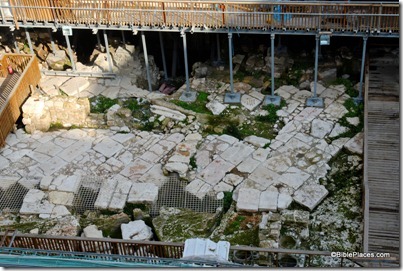When one looks at the amount of information preserved in the archaeological record in the city of Jerusalem, a pattern emerges where a period of abundant evidence is followed by one with minimal data. What can archaeology tell us about Jerusalem in the Late Bronze or Persian periods? Not very much, especially by comparison with the eras that precede and follow. Historical documentation, such as the Amarna Letters and the books of Ezra and Nehemiah, attest to flourishing life in the city in these periods, but the archaeological evidence is quite limited. One might simplify the record as follows:
- Middle Bronze: Abundance
- Late Bronze-Iron I: Minimal
- Iron II: Abundance
- Persian-Hellenistic: Minimal
- Hasmonean-Herodian: Abundance
- Late Roman: Minimal
- Byzantine: Abundance
One of the reasons for this situation is that later builders apparently destroyed and re-used much of the material from the previous period. Thus the Hasmoneans rebuilt along Nehemiah’s (Persian) walls and David reused existing Jebusite structures.
The Late Roman period (AD 70-330) is one of those for which less archaeological information exists.
But excavations in the last decade have made significant progress in revealing more about the city between the destruction of the Second Temple and the arrival of the Byzantines. Nir Hasson has written an interesting article on Jerusalem in the Late Roman period, noting in particular four discoveries from this period (emphasis added below).
In the rear section of the Western Wall plaza, in the spot where the Western Wall Heritage Foundation intends to erect a large building that it calls “the Core House,” Antiquities Authority researcher Shlomit Wexler-Bedolah discovered an ornate and broad Roman street, complete with shops on each side. This is the eastern cardo, along whose path Hagai Street would later be paved.
Three hundred meters to the south, another Antiquities Authority researcher, Dr. Doron Ben-Ami, discovered the place where the Roman street apparently ended. The corner of the street is adjacent to the Givati parking lot at the top of the Silwan valley – the spot where the Elad organization intends to build a large visitors center. In a large rescue excavation at this location in recent years, Ben-Ami exposed a large, fancy Roman villa unlike any other structure from its time in the entire country. He estimates that the villa he uncovered was the home of the regional governor or some other central authority.
In another excavation, in the tunnel under the Western Wall, Wexler-Bedolah and archaeologist Alexander Onn re-estimated the dating of a large bridge leading to the Temple Mount. As with other ancient monuments this too turned out to be of Roman origin and not from the Second Temple period. Another example is the Roman bathhouse and swimming pool discovered by Sion a year and a half ago. “It’s a tremendous spa, a country club,” Sion says, comparing the bathhouse to similar facilities found in other parts of the Roman Empire.
The rest of the article describes other discoveries in the greater Jerusalem area and it discusses the implications of this new information, including what it means for the alleged abandonment of the Temple Mount during these years. If you’re interested in the history of Jerusalem, this is worth reading.
HT: Joseph Lauer

One thought on “Roman Jerusalem”
Regarding the minimal data in the Persian-Hellenistic periods, you might have said, "Thus Nehemiah rebuilt along Hezekiah's (Iron II) wall…"